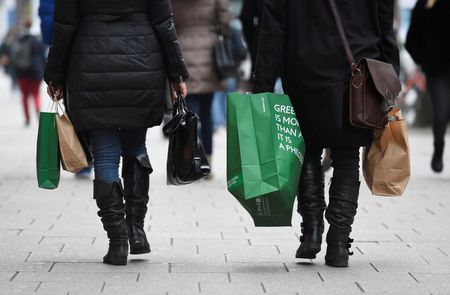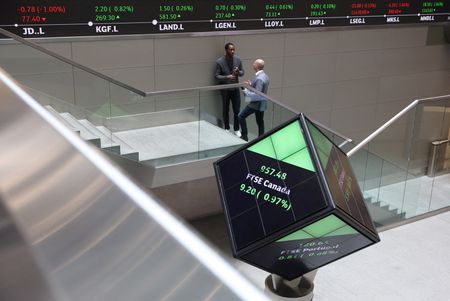By Maria Martinez
BERLIN (Reuters) -The German economy grew in the first quarter of the year thanks to consumption and investment, escaping a recession, but the unemployment rate rose to a decade high showing how economic weakness is taking its toll on the labour market.
Gross domestic product rose in line with forecasts by 0.2%, compared with the previous three-month period, preliminary data from the statistics office showed on Wednesday.
“As much as any positive growth number coming out of Germany is highly appreciated these days, the quarterly increase is still far too small to end the country’s long-lasting stagnation,” said Carsten Brzeski, global head of macro at ING.
German GDP had contracted in the final quarter of last year by 0.2%, reigniting fears of recession, which is defined as two consecutive quarters of contraction.
Germany was the only member of the Group of Seven advanced economies that has failed to grow for the last two years, and the tariffs announced by the U.S., its main trading partner, will deal a further blow – potentially putting it on track for a third year of contraction for the first time.
The Ifo Institute fears that the German economy will contract again as early as the summer.
Due to tariffs fears, goods purchases in the U.S. were brought forward, benefiting exports and industrial production in Germany in the first quarter, said Timo Wollmershaeuser, head of forecasts at Ifo.
“However, the noticeable increase in tariffs on imports from the EU that came into force in April and the threat of further tariff increases weighed on the further course of the economy in Germany,” said Wollmershaeuser.
Separate data from the labour office showed on Wednesday that the number of people out of work in Germany rose less than expected in April, but the unemployment rate rose to its highest level since the pandemic.
The office said the number of people unemployed increased by 4,000 in seasonally adjusted terms to 2.92 million, roughly the same level as in March. Analysts polled by Reuters had expected a rise of 15,000.
The number of unemployed people in Germany is approaching the 3-million mark for the first time in 10 years.
The seasonally adjusted jobless rate rose to 6.3% from 6.2% in the previous month. Excluding the pandemic, this is the highest level since December 2015.
“The U.S. tariff policy remains a major uncertainty factor, which is dampening the willingness to hire, particularly in the export-orientated manufacturing sector,” said Marc Schattenberg, economist at Deutsche Bank.
ECONOMIC CHALLENGES FACE NEW GOVERNMENT
The data comes as a new conservative-led government prepares to take office next week with the Social Democrats. Reviving Europe’s largest economy will be one of its main challenges.
“If the potential new government now manages to leave words behind and show with deeds that they want to move the country forward, then this spark could spread to companies and private households,” said Cyrus de la Rubia, chief economist at Hamburg Commercial Bank.
To avoid a third year of contraction in 2025, economists say that boosting consumption in Germany is crucial.
Although retail sales were positive in January and February, data published on Wednesday showed they fell 0.2% in March from the prior month, while import prices gained, pointing to higher inflation ahead.
Analysts polled by Reuters had predicted a 0.4% decrease in retail sales.
“After two years of recession and in view of the flood of unsettling news that hits people on a daily basis, it is obviously not so easy to look to the future with more confidence and to be a little more generous with consumer wishes,” de la Rubia said.
Germany’s corporate sector is also struggling with the uncertainty from U.S. tariffs. Mercedes-Benz on Wednesday pulled its earnings guidance and Volkswagen said it expects profit margins this year to be at the bottom end of its forecast.
German import prices increased by 2.1% year-on-year in March, the statistics office said. Analysts polled by Reuters had predicted a 2.6% increase.
Since the German economy purchases many primary products and raw materials abroad, higher import prices are reflected in inflation data with a time lag.
Germany will publish national inflation data for April later on Wednesday, with the rate expected to slow to 2.1% from 2.3% the previous month.
(Reporting by Maria Martinez in Berlin, Marleen Kaesebier and Cian Muenster in Gdansk, Editing by Kirsti Knolle, Sharon Singleton, Ros Russell)










